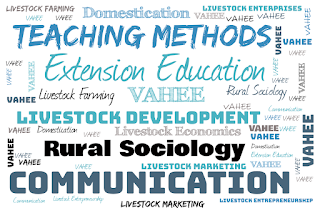Topic: Adoption and diffusion of Innovations, stages of adoption, adopter categories, innovation decision process, attributes of innovations, diffusion process, factor affecting adoption and diffusion process. (From Unit 4, VAHEE) *VAHEE- Veterinary and Animal Husbandry Extension Education.
Adoption and Diffusion of Innovations
by Dr. Debasish Saha, Department of VAHEE, F/O-VAS, of WBUAFS.
Download this Note in PDF format - Download here»
Adoption and Diffusion of Innovations
- Adoption is a decision to make full use of an innovation as the best course of action available. Rejection is a decision not to adopt an innovation. The small - scale trial is often part of the decision to adopt, and is important as a means to decrease the perceived uncertainty of the innovation for the adopter.
- Diffusion is the process by which an innovation is communicated through certain channels over time among the members of a social system. It is a special type of communication, in that the messages are concerned with new ideas.
- Innovation is commonly defined as the "carrying out of new combinations” that include “the introduction of new goods, ... new methods of production, ... the opening of new markets, ... the conquest of new sources of supply ... and the carrying out of a new organization of any industry”.
- Diffusion of Innovations is a theory of how, why, and at what rate new ideas and technology spread through cultures.
- The concept was first studied by the French sociologist Gabriel Tarde (1890) and by German and Austrian anthropologists such as Friedrich Ratzel and Leo Frobenius.
- The publication of a study of Ryan and Gross on the diffusion of hybrid corn in Iowa was the first sustainably visible contribution in a broader interest in innovations.
- Diffusion of Innovations is defined as "the process by which an innovation is communicated through certain channels over time among the members of a social system" (Rogers,).
Elements of Diffusion of Innovations
The key elements in diffusion research are:
Innovation
Rogers defined an innovation as "an idea, practice, or object
that is perceived as new by an individual or other unit of adoption"
Communication channels
A communication channel is "the means by which messages get
transferred from one individual to another"
Time
"The innovation-decision period is the length of time required
to pass through the innovation-decision process" "Rate of adoption is the relative
speed with which an innovation is adopted by members of a social system"
Social system
"A social system is defined as a set of interrelated units that are
engaged in joint problem solving to accomplish a common goal"
Types of Innovation Decisions
An individual or an organization/social system bases the type of decision on
whether an innovation is adopted/rejected.
The three types of innovation-decisions are:
- Optional innovation-decisions,
- Collective innovation-decisions,
- Authority innovation-decisions.
Optional Innovation-Decision
This decision is made by an individual who is in some way distinguished
from others in a social system.
Collective Innovation-Decision
This decision is made collectively by all individuals of a social system.
Authority Innovation-Decision
This decision is made for the entire social system by few individuals in
positions of influence or power.
Stages in Adoption Process
Diffusion of an innovation occurs through a five–step process. This process are
type of decision-making.
It occurs through a series of communication channels over a period of time among
the members of a similar social system. The five stages in the adoption process are:
- Knowledge,
- Persuasion,
- Decision,
- Implementation and
- Confirmation.
Knowledge: In this stage the individual is first exposed to an innovation but lacks
information about the innovation.
o It should be noted that during this stage of the process the individual
has not been inspired to find more information about the innovation.
Persuasion: In this stage the individual is interested in the innovation and actively
seeks information/detail about the innovation.
Decision: In this stage the individual takes the concept of the innovation and
weighs the advantages/disadvantages of using the innovation and decides whether
to adopt or reject the innovation.
Implementation: In this stage the individual employs the innovation to a varying
degree depending on the situation. During this stage the individual determines the
usefulness of the innovation and may search for further information about it.
Confirmation: Although the name of this stage may be misleading, in this stage the
individual finalizes his decision to continue using the innovation and may use the
innovation to its fullest potential.
Characteristic of Innovations
- Rogers defined several intrinsic characteristics of innovations that influence an individual’s decision to adopt or reject an innovation.
- The relative advantage is how improved an innovation is over the previous generation.
- Compatibility is the second characteristic, the level of compatibility that an innovation has to be assimilated into an individual’s life.
- The complexity of an innovation is a significant factor in whether it is adopted by an individual. If the innovation is too difficult to use an individual may not adopt it.
- The fourth characteristic, trialability, determines how easily an innovation may be experimented with as it is being adopted.
- The final characteristic, observability, is the extent that the results of an innovation are visible.
Innovativeness and Adopter Categories
- Innovativeness is the degree to which an individual is relatively earlier in adopting new ideas rather than other members of his social system (Rogers, 2000).
- Rogers defined an adopter category as a classification of individuals within a social system on the basis of innovativeness. The categories of adopters are: innovators, early adopters, early majority, late majority, and laggards. Innovators: Innovators are the first individuals to adopt an innovation. Innovators are willing to take risks, youngest in age, have the highest social class, have great financial lucidity, very social and have closest contact to scientific sources and interaction with other innovators. Early Adopters: This is second fastest category of individuals who adopt an innovation. These individuals have the highest degree of opinion leadership among the other adopter categories.
- Early adopters are typically younger in age, have a higher social status, have more financial lucidity, advanced education, and are more socially forward than late adopters Early Majority: Individuals in this category adopt an innovation after a varying degree of time. This time of adoption is significantly longer than the innovators and early adopters.
- Early Majority tend to be slower in the adoption process, have above average social status, contact with early adopters, and show some opinion leadership. Late Majority: Individuals in this category will adopt an innovation after the average member of the society. These individuals approach an innovation with a high degree of skepticism and after the majority of society has adopted the innovation.
- Late Majority are typically skeptical about an innovation, have below average social status, very little financial lucidity, in contact with others in late majority and early majority, very little opinion leadership. Laggards: Individuals in this category are the last to adopt an innovation. Unlike some of the previous categories, individuals in this category show little to no opinion leadership. These individuals typically have an aversion to change-agents and tend to be advanced in age.
- Laggards typically tend to be focused on “traditions”, have lowest social status, lowest financial fluidity, oldest of all other adopters, in contact with only family and close friends, very little to no opinion leadership.
You will find almost all the Veterinary Notes fully free in PDF format from "BVSc & AH Notes" corner of E-Learning in this website. Hope the note will benefited you. Share with your Vet Friends and Family. For any query knock us. Stay tuned. Thank You. Happy Learning!










